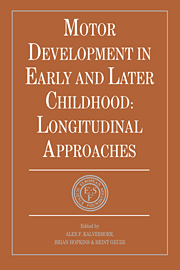Book contents
- Frontmatter
- Contents
- List of contributors
- Foreword
- Preface
- SETTING THE SCENE
- SECTION I BIOLOGICAL BASIS OF MOTOR DEVELOPMENT
- SECTION II DEVELOPMENT OF BODY POSTURE AND GOAL-DIRECTED REACHING
- SECTION III MOTOR DEVELOPMENT, EARLY COMMUNICATION AND COGNITION
- SECTION IV ACQUISITION OF SKILLS
- 12 Individual patterns of tool use by infants
- 13 Tool use, hand cooperation and the development of object manipulation in human and non-human primates
- 14 Handwriting: a developmental perspective
- 15 Development of children's writing performance: some educational implications
- SECTION V MOTOR DEVELOPMENT AND HANDICAP
- SECTION VI METHODOLOGICAL AND CONCEPTUAL CONSIDERATIONS
- Epilogue: description versus explanation
- Index
12 - Individual patterns of tool use by infants
from SECTION IV - ACQUISITION OF SKILLS
Published online by Cambridge University Press: 05 May 2010
- Frontmatter
- Contents
- List of contributors
- Foreword
- Preface
- SETTING THE SCENE
- SECTION I BIOLOGICAL BASIS OF MOTOR DEVELOPMENT
- SECTION II DEVELOPMENT OF BODY POSTURE AND GOAL-DIRECTED REACHING
- SECTION III MOTOR DEVELOPMENT, EARLY COMMUNICATION AND COGNITION
- SECTION IV ACQUISITION OF SKILLS
- 12 Individual patterns of tool use by infants
- 13 Tool use, hand cooperation and the development of object manipulation in human and non-human primates
- 14 Handwriting: a developmental perspective
- 15 Development of children's writing performance: some educational implications
- SECTION V MOTOR DEVELOPMENT AND HANDICAP
- SECTION VI METHODOLOGICAL AND CONCEPTUAL CONSIDERATIONS
- Epilogue: description versus explanation
- Index
Summary
INTRODUCTION
In essence, science is the study of patterns. The scientist's task is to search for regularities, i.e. patterns, and having detected one provide a satisfactory explanation for it. In the behavioural domain different kinds of question can be asked about patterns and different kinds of explanation are appropriate. Tinbergen (1963) distinguished four general classes of explanation: causal, developmental, functional and evolutionary. The first is concerned with proximate cause and seeks to identify internal and external factors which produce the behaviour in question. The second is concerned with how the behaviour arose in the lifetime of the individual. The third relates to the functions which the behaviour serves in a given ecological niche, and the fourth is concerned with how the behaviour evolved during the history of the species. Our primary interest is in how children develop skilled motor actions; that is to say, how they assemble patterns of behaviour. Although some developmental research has been concerned with end points, with the relationship between state1 and staten – e.g. the existence of a correlation between scores on an infant performance test and scores on an intelligence test given in middle childhood – the essential issue concerns the connecting pathway. An understanding of development entails knowing the transitions and transformations which connect state1 with staten.
- Type
- Chapter
- Information
- Motor Development in Early and Later ChildhoodLongitudinal Approaches, pp. 174 - 204Publisher: Cambridge University PressPrint publication year: 1993
- 13
- Cited by



